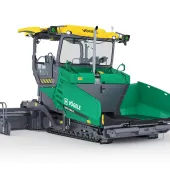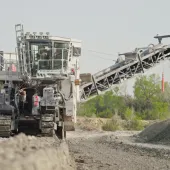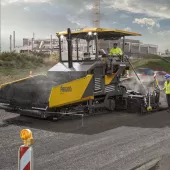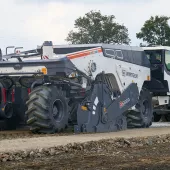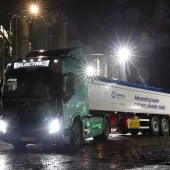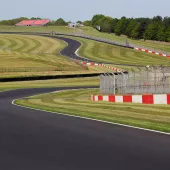Two Vögele InLine Pave trains work ‘Hot to Hot’
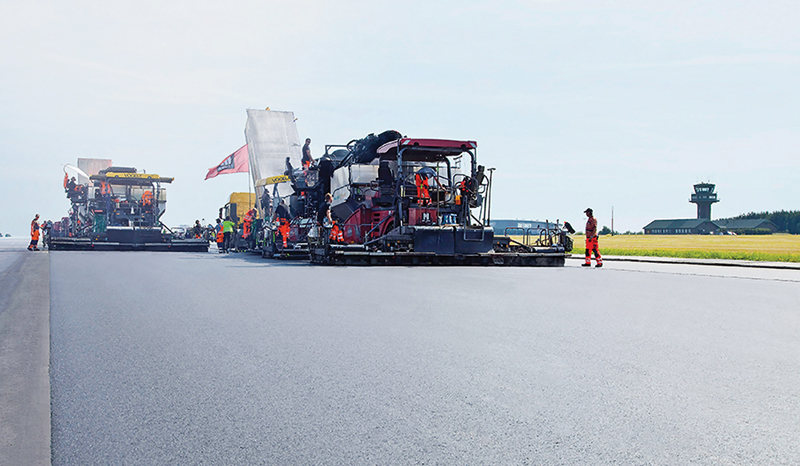
First published in the January 2016 issue of Quarry Management
Airport runway rehabilitated in record time with 15m-wide compact asphalt pavement built in a single pass
Schedules for runway rehabilitations are always exceedingly tight, and a recent project at Rostock-Laage Airport, in Germany, was no exception. Here, though, a new approach was taken: two InLine Pave trains from Vögele were used to lay a new surface and binder course both ‘hot on hot’ and ‘hot to hot’ as a compact asphalt pavement. As a result, contractors Kemna Schwerin Tief- und Straßenbau GmbH not only finished the job at record speed, but also delivered maximum paving quality.
FOD, for an airport operator, is like a red rag to a bull. The abbreviation stands for ‘foreign object damage’ and describes the danger to aircraft posed by small objects on the runway – even items as small as 4mm in size can destroy an entire engine. This particular problem had arisen at Rostock-Laage Airport after bubbles – and subsequently cracks – had formed on the runway. This meant that large parts of the 2.5km-long surface had to be rehabilitated – and as quickly as possible, in order to minimize the disruption to flight operations.
Ideal solution: the InLine Pave process
‘The compact asphalt pavement using the InLine Pave process looked like the ideal solution in this case,’ explained Bernd Kanscheit, an engineer at German engineering consultancy Mecklenburgisches Ingenieurbüro für Verkehrsbau. ‘First, InLine Pave gives you an excellent bond between layers – which prevents bubbles from forming. Secondly, the InLine Pave surface is very dense and low in voids, so neither water nor de-icing agents can cause damage. Thirdly, we benefit from the very high compaction of the binder course in the InLine Pave process. It is higher than in conventional paving, and that’s particularly important to us here, where the characteristic load profile of the take-off and landing runway means we cannot expect post-compaction by vehicles.
In addition to the requirements placed on the asphalt, organizational aspects also made InLine Pave a suitable choice, as the binder and surface course could be laid rapidly in one pass. Also, the pavement was going to be laid in potentially cool autumn weather, but with the InLine Pave process, the asphalt stores a considerable amount of heat, which ensures both correct compaction and slow cooling.
Once the go-ahead was given, the road construction contractor had just 10 days in which to mill off the 95,300m2 centre portion of the take-off and landing runway, lay the asphalt with a new profile, apply all the required markings and clean the entire surface. Flights at the airport, which is used for both military and civilian aviation, were suspended during this period.
Before the pavers could get started, four Wirtgen W210 large milling machines removed the asphalt. The Kemna team began to lay a level-regulating layer of asphaltic concrete while the milling work was still taking place. Using two Vögele Super 2100-2 pavers, they established a 4–8cm thick layer with a slope angle of 1.5% to each side, which guarantees water drainage. The grade and slope control was carried out in the longitudinal direction by scanning tensioned wires. Kemna were already working ‘hot to hot’ with the Vögele pavers. A quasi-jointless strip with a width of approximately 15m was laid on both sides, starting from the middle.
InLine Pave permits a thinner surface course
On top of the sloped and very even level-regulating layer, the InLine Pave train then laid the binder course together with the surface course in a constant thickness. Unlike the previous pavement structure, the new surface course is only 2.5cm thick instead of 4cm. ‘We based our measurements of the surface course on the requirements of the German terms and guidelines for the construction of asphalt roadways (ZTV Asphalt StB). The operators of the airport were absolutely delighted with the savings this delivered in terms of surface course material,’ explained Mr Kanscheit.
Minimizing the cost of future maintenance operations was the reason for another technical requirement set by the airport operators: the landing runway was to have no longitudinal joint for 10m to the right or left of the centre, as experience has shown that this gives the longest maintenance intervals. To ensure this precise functionality, Mr Kanscheithe put the compact asphalt pavement out to tender in combination with ‘hot-to-hot’ paving.
Kemna completed the paving with two InLine Pave trains in just three days. On the first day, the teams, each consisting of two pavers and a material feeder, worked in parallel on the outside edges of the runway, with each laying a 7.5m-wide strip. The second day saw the binder and surface courses laid ‘hot on hot’ and ‘hot to hot’ with Vögele InLine Pave. Starting from the middle of the runway, a 15m-wide compact asphalt pavement was thus created in a single pass. On the third day, the final 15m-wide asphalt strip was laid on the opposite side in the same procedure.
17,700 tonnes in three days
The changes in the paving widths of the screeds did not present any problems, because Vögele equip their InLine Pave trains with hydraulically extending and retracting screeds, so anywhere between 3.0m and 8.5m in width is possible. This allowed the Kemna team to lay 5,900 tonnes of asphalt on each of three successive working days while meeting the high quality requirements of the customer. ‘The ‘hot-to-hot’ joint is as good as invisible,’ said a delighted Torben Eymer, engineer and site manager. Mr Kanscheit added: ‘Samples show that there are no structural irregularities in the binder at the joint. And that’s exactly what’s required.’
Apart from the ‘hot-to-hot’ paving with InLine Pave, another highlight on the job site was the PowerFeeder MT 3000-2 Offset from Vögele, which ensured that both pavers were kept permanently supplied with material. With a paving speed of around 4m per minute and a paving width of 7.5m, the offset material feeder delivered some 400 tonnes/h of material to the pavers, comprising approximately 280 tonnes for the binder course and 120 tonnes for the surface course.
The offset material feeder also proved invaluable when it came to laying the narrow 3.4m-wide shoulder. ‘If the mix had been delivered directly by a lorry, the existing edge of the surface up to the shoulder would certainly have sustained damage,’ said Mr Eymer. ‘Thanks to the pivoting conveyor, the lorries were able to drive alongside, and not only did that enhance our quality, it also made us considerably quicker.’
Schedule met
Kemna were able to complete the job within the tight timescale just 10 days after getting started. ‘We thought of everything and the whole job went according to plan,’ concluded a very satisfied Torben Eymer. ‘After this premiere with a 15m-wide strip paved with the InLine Pave train, I’m confident of one thing: this technology has a great future, especially for large projects.’
For further information visit: www.wirtgen.co.uk
- Subscribe to Quarry Management, the monthly journal for the mineral products industry, to read articles before they appear on Agg-Net.com


